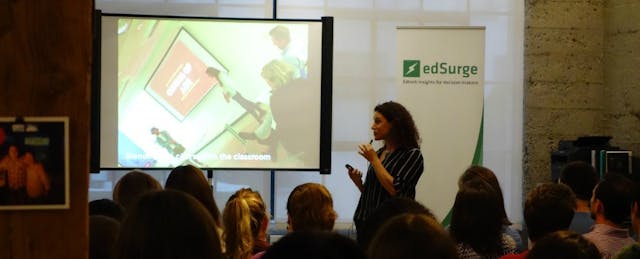In a Meetup hosted by EdSurge on Aug. 17, more than 100 people gathered to hear speakers present how their organizations are embracing the future of digital learning. Held at NovoEd’s headquarters, five speakers gave their six-minute lightning talks and then led a smaller group discussion with attendees.
Here is a recap of the event, adapted from a blog post by NovoEd:
Suzanne Gibbs Howard, Dean, IDEO U
Suzanne Gibbs Howard, dean at IDEO U, says her university’s imperative is teaching creativity and problem-solving. She laid out their belief that in a world of constant change, those who are best equipped are those who generate new ideas when the path is unclear. To scale this capability, IDEO formed IDEO U and developed the capability to teach these skills online.
Howard made the case that teaching creativity is not a linear activity, and referenced IDEO U’s “creative confidence pedagogy” that represents their approach to teaching, which includes see, try, share and reflect.
She referenced three examples of creative uses by IDEO U students, from Jess in Melbourne, who formed her own in-person local learning circle to employees at an architecture firm in Italy who used a prototyping leader’s guide to help them work on a common project during their weekly happy hours.
Candace Thille, Head of Stanford Open Learning Initiative (OLI)
Researcher Candace Thille of Stanford University is notable for developing the Open Learning Initiative at Carnegie-Mellon University, which has moved to Stanford. Thille not only helped put personalized learning on the map, but also implemented it with specific university courseware, which was shown through rigorous research to be more effective than standard teaching methods.
Thille emphasized starting with the learner when we consider edtech research and products. Collaborating with her Stanford colleagues, Thille has been looking for ways to take additional learner factors into account, particularly social-psychological components.
She described the advances in cognitive science, including the work of Carol Dweck, Geoffrey Cohen, and Claude Steele, that have led her to work on creating even more supportive and effective learning environments.
Thille expressed excitement over the potential to develop better algorithms for personalized learning systems, but also raised concerns that having these developed and kept proprietary by private companies may not be helpful in advancing the field of research in personalized learning.
Marco Molinaro, Vice Provost for Educational Effectiveness, UC Davis
Marco Molinaro is vice provost for educational effectiveness at UC Davis, where he is challenged with finding ways to improve the learning experience. Molinaro says he tried approaching faculty, but found they were hesitant to change.
However, they were more open to having their teaching assistants try new approaches. So he implemented new approaches with teaching assistants for an introduction to biology course. The TAs were trained in new techniques to conduct their sections, and the results seemed clear: a half standard deviation improvement and an increased pass rate in the class.
According to Molinaro, UC Davis began adopting this approach more widely with the Undergraduate STEM Education Initiative. Molinaro noted, however, that they haven’t yet reached nirvana — staff and faculty involved wished for easier ways for multiple systems to talk with one another and more advanced data analysis.
Jonathan Katzman, Chief Product Officer, Minerva Project
Minerva has been a hot education initiative in Silicon Valley, and CPO Jonathan Katzman spoke about how they started this modern university from scratch.
Katzman discussed the unique advantages of designing a pedagogy from the ground up, including building the technology that will be utilized. Minerva’s perspective is that they can’t predict what the jobs of the future will be, so they focus on developing practical knowledge, he says.
According to Katzman, Minerva strives for four core competencies: creative thinking, critical thinking, effective communication and effective interaction. They broke down these four competencies to 120 objectives and use them to guide their teaching experiences.
Minerva prefers the more intimate approach of small seminars with 15 to 20 students, Katzman says. At the program, there is no clear distinction between online or offline, but instead, it is all interwoven. They make use of a digital classroom interaction tool, dubbed the Active Learning Forum, which allows for lively virtual experience, including polling, cold calling and stats captured, and even allowing teachers to go back and watch “game tape” to give additional comments or feedback to students.
In addition to new methods, Minerva is implementing various methods to measure success using assessments, surveys and employer feedback from summer internship sponsor companies.
Bridget Burns, Executive Director, University Innovation Alliance
Bridget Burns of the University Innovation Alliance works to support students of all family backgrounds to succeed at the university. Together, they serve nearly 400,000 students at some of the nation’s top public universities, Burns says.
This focus has become increasingly important, as we, for the first time in history, reached a point where students from low-income families will form the majority in K-12 schools.
You can’t be a superhero, Burns told the audience. Rather, educators need to work within the system and with the well-intentioned people within them, and it helps to spend time asking questions before diving in with a solution.
Have empathy, Burns continued. Most people work within higher education because they care about people. Tap into this by connecting with them. Lastly, project Management is critical — Burns suggests spending half your time or more on this.
“Tolerating and moving through bureaucracy is a skill—a rare skill,” Burns says.
Note: A longer version of this post originally appeared on NovoEd’s blog.


